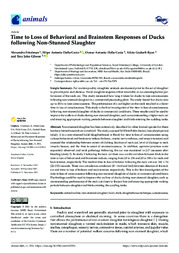Time to loss of behavioral and brainstem responses of ducks following non-stunned slaughter.
Time to loss of behavioral and brainstem responses of ducks following non-stunned slaughter.
Author(s): FRIEDMAN, A.; DALLA COSTA, F. A.; DALLA COSTA, O. A.; RYAN, A. G.; GIBSON, T. J.
Summary: Abstract: Non-stunned slaughter has been extensively described for other farmed species but there has been limited research on waterfowl. The study assessed 34 White Pekin ducks (Anas platyrhynchos) (study 1) in a non-stunned halal slaughterhouse in Brazil for time to loss of consciousness using various behavioral and brainstem indices (balance, cranial nerve reflexes, and muscle tension) and assessed the relationship between extent of clotting, location of neck cut, level of damage to neck vessels/tissues, and the time to onset of unconsciousness. In addition, operator practices were separately observed and neck pathology following the cut was examined in 217 carcasses after bleeding (study 2). In study 1 following the neck cut there was a wide variation between birds in the time to loss of behavioral and brainstem indices, ranging from 20 to 334 and 20 to 383 s for neck and beak tension, respectively. The median time to loss of balance following the neck cut was 166 ± 14 (22?355) seconds. There was a moderate correlation (R = 0.60 and 0.62) between distance of the neck cut and time to loss of balance and neck tension, respectively. This is the first investigation of the time to loss of consciousness following non-stunned slaughter of ducks in commercial conditions. The findings could be used to improve the welfare of ducks during non-stunned slaughter, such as recommending performance of the neck cut closer to the jaw line and ensuring appropriate waiting periods between slaughter and birds entering the scalding tanks.
Publication year: 2021
Types of publication: Journal article
Unit: Embrapa Swine & Poultry
Keywords: Abate, Abatedouro, Animal welfare, Bem-estar animal, Ducks, Pato, Slaughter, Slaughterhouses
Observation
Some of Embrapa's publications are published as ePub files. To read them, use or download one of the following free software options to your computer or mobile device. Android: Google Play Books; IOS: iBooks; Windows and Linux: Calibre.
Access other publications
Access the Agricultural Research Database (BDPA) to consult Embrapa's full library collection and records.
Visit Embrapa Bookstore to purchase books and other publications sold by Embrapa.

